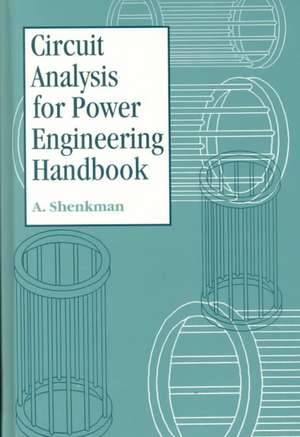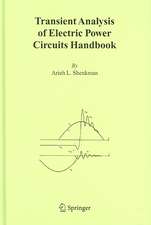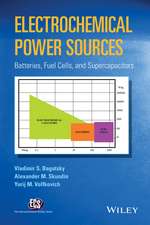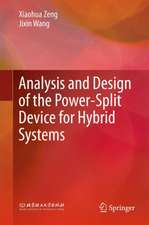Circuit Analysis for Power Engineering Handbook
Autor Arieh L. Shenkman, Moses Zarudien Limba Engleză Hardback – 31 ian 1999
| Toate formatele și edițiile | Preț | Express |
|---|---|---|
| Paperback (1) | 1238.23 lei 6-8 săpt. | |
| Springer Us – 3 oct 2012 | 1238.23 lei 6-8 săpt. | |
| Hardback (1) | 1244.89 lei 6-8 săpt. | |
| Springer Us – 31 ian 1999 | 1244.89 lei 6-8 săpt. |
Preț: 1244.89 lei
Preț vechi: 1518.16 lei
-18% Nou
Puncte Express: 1867
Preț estimativ în valută:
238.24€ • 247.81$ • 196.68£
238.24€ • 247.81$ • 196.68£
Carte tipărită la comandă
Livrare economică 14-28 aprilie
Preluare comenzi: 021 569.72.76
Specificații
ISBN-13: 9780412831805
ISBN-10: 0412831805
Pagini: 735
Ilustrații: XIV, 735 p.
Dimensiuni: 155 x 235 x 40 mm
Greutate: 1.23 kg
Ediția:1998
Editura: Springer Us
Colecția Springer
Locul publicării:New York, NY, United States
ISBN-10: 0412831805
Pagini: 735
Ilustrații: XIV, 735 p.
Dimensiuni: 155 x 235 x 40 mm
Greutate: 1.23 kg
Ediția:1998
Editura: Springer Us
Colecția Springer
Locul publicării:New York, NY, United States
Public țintă
ResearchCuprins
1 Topological methods of circuit analysis.- 1.1 Introduction.- 1.2 The concept of a graph.- 1.3 Incidence, loop and mesh matrices.- 1.4 Generalized matrix approach in circuit analysis.- 1.5 Tellegen’s theorem and conservation of energy.- 1.6 Dual graphs and dual circuits.- 1.7 Computer-aided analysis of very complex circuits.- 2 Sinusoidal steady-state analysis.- 2.1 Introduction.- 2.2 The phasor concept and complex representation of sinusoids.- 2.3 Phasor relationships for R, L and C elements; complex impedance and admittance.- 2.4 Analysis of complex a.c. circuits.- 2.5 Resonance in a.c. circuits.- 2.6 Energy and power in a.c. circuits.- 2.7 Linear and circle diagrams.- 3 Magnetically Coupled Circuits.- 3.1 Introduction.- 3.2 Mutual inductance.- 3.3 Series and parallel connections of coupled elements.- 3.4 Energy storage and power transfer.- 3.5 Transformers.- 3.6 Resonance in coupled circuits.- 3.7 Circuits with more than two coupled elements.- 4 Three-phase systems.- 4.1 Introduction.- 4.2 Polyphase circuits.- 4.3 Three-phase generators.- 4.4 Three-phase connections.- 4.5 Power measurements in three-phase systems.- 4.6 Three-phase transformers.- 4.7 The rotating magnetic field.- 4.8 The principle of induction (asynchronous) and synchronous machines.- 4.9 Symmetrical components.- 5 Non-sinusoidal behavior of electric circuits.- 5.1 Introduction.- 5.2 Fourier series.- 5.3 Circuit analysis for non-sinusoidal functions.- 5.4 Characteristics of non-sinusoidal functions.- 5.5 Power due to non-sinusoidal voltages and currents.- 5.6 Factors characterizing non-sinusoidal waves.- 5.7 Harmonics in three-phase systems.- 6 Transmission lines.- 6.1 Introduction.- 6.2 Transmission line (TL) parameters.- 6.3 Transmission line equations.- 6.4 Sinusoidal response of a transmissionline.- 6.5 Waves in transmission lines.- 6.6 Solution of transmission line equations.- 6.7 Characteristic parameters of a transmission line.- 6.8 Some properties of transmission lines.- 6.9 A transmission line in various operating conditions.- 6.10 Equivalent circuit of a transmission line.- 6.11 Ladder network as a TL model.- 7 Transient analysis using Laplace transform techniques.- 7.1 Introduction.- 7.2 Definition of the Laplace transform.- 7.3 Laplace transform of some simple time functions.- 7.4 Basic theorems of the Laplace transform.- 7.5 Initial-value and final-value theorems.- 7.6 Convolution theorem.- 7.7 Inverse transform and partial-fraction expansions.- 7.8 Circuit analysis with the Laplace transform.- 8 Transient behavior of transmission lines (TL).- 8.1 Introduction.- 8.2 The differential equations of TL and their solution.- 8.3 Travelling-wave properties in a transmission line.- 8.4 Wave formations in TL at their connections.- 8.5 Wave reflections.- 8.6 Successive reflections of waves.- 8.7 Laplace transform analysis of transients in TL.- 8.8 Line with only LG or CR parameters.- Appendix A.- Appendix B.









